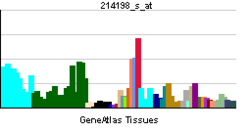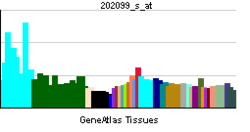- DGCR2
-
DiGeorge syndrome critical region gene 2 Identifiers Symbols DGCR2; DGS-C; DKFZp686I1730; IDD; KIAA0163; LAN; SEZ-12 External IDs OMIM: 600594 MGI: 892866 HomoloGene: 31292 GeneCards: DGCR2 Gene Gene Ontology Molecular function • receptor activity
• binding
• sugar bindingCellular component • microsome
• membrane
• integral to membraneBiological process • cell adhesion
• organ morphogenesis
• response to drugSources: Amigo / QuickGO RNA expression pattern 

More reference expression data Orthologs Species Human Mouse Entrez 9993 13356 Ensembl ENSG00000070413 ENSMUSG00000003166 UniProt P98153 n/a RefSeq (mRNA) NM_001173533.1 NM_010048 RefSeq (protein) NP_001167004.1 NP_034178 Location (UCSC) Chr 22:
19.02 – 19.11 MbChr 16:
17.84 – 17.89 MbPubMed search [1] [2] Integral membrane protein DGCR2/IDD is a protein that in humans is encoded by the DGCR2 gene.[1][2][3]
Deletions of the 22q11.2 have been associated with a wide range of developmental defects (notably DiGeorge syndrome, velocardiofacial syndrome, conotruncal anomaly face syndrome and isolated conotruncal cardiac defects) classified under the acronym CATCH 22. The DGCR2 gene encodes a novel putative adhesion receptor protein, which could play a role in neural crest cells migration, a process which has been proposed to be altered in DiGeorge syndrome.[3]
References
- ^ Wadey R, Daw S, Taylor C, Atif U, Kamath S, Halford S, O'Donnell H, Wilson D et al. (Oct 1995). "Isolation of a gene encoding an integral membrane protein from the vicinity of a balanced translocation breakpoint associated with DiGeorge syndrome". Hum Mol Genet 4 (6): 1027–1033. doi:10.1093/hmg/4.6.1027. PMID 7655455.
- ^ Kajiwara K, Nagasawa H, Shimizu-Nishikawa K, Ookura T, Kimura M, Sugaya E (Jun 1996). "Cloning of SEZ-12 encoding seizure-related and membrane-bound adhesion protein". Biochem Biophys Res Commun 222 (1): 144–148. doi:10.1006/bbrc.1996.0712. PMID 8630060.
- ^ a b "Entrez Gene: DGCR2 DiGeorge syndrome critical region gene 2". http://www.ncbi.nlm.nih.gov/sites/entrez?Db=gene&Cmd=ShowDetailView&TermToSearch=9993.
Further reading
- Demczuk S, Aledo R, Zucman J et al. (1995). "Cloning of a balanced translocation breakpoint in the DiGeorge syndrome critical region and isolation of a novel potential adhesion receptor gene in its vicinity". Hum. Mol. Genet. 4 (4): 551–558. doi:10.1093/hmg/4.4.551. PMID 7633403.
- Nagase T, Seki N, Ishikawa K et al. (1996). "Prediction of the coding sequences of unidentified human genes. V. The coding sequences of 40 new genes (KIAA0161-KIAA0200) deduced by analysis of cDNA clones from human cell line KG-1". DNA Res. 3 (1): 17–24. doi:10.1093/dnares/3.1.17. PMID 8724849.
- Gong W, Emanuel BS, Collins J et al. (1996). "A transcription map of the DiGeorge and velo-cardio-facial syndrome minimal critical region on 22q11". Hum. Mol. Genet. 5 (6): 789–800. doi:10.1093/hmg/5.6.789. PMID 8776594.
- Strausberg RL, Feingold EA, Grouse LH et al. (2003). "Generation and initial analysis of more than 15,000 full-length human and mouse cDNA sequences". Proc. Natl. Acad. Sci. U.S.A. 99 (26): 16899–16903. doi:10.1073/pnas.242603899. PMC 139241. PMID 12477932. http://www.pubmedcentral.nih.gov/articlerender.fcgi?tool=pmcentrez&artid=139241.
- Colland F, Jacq X, Trouplin V et al. (2004). "Functional proteomics mapping of a human signaling pathway". Genome Res. 14 (7): 1324–1332. doi:10.1101/gr.2334104. PMC 442148. PMID 15231748. http://www.pubmedcentral.nih.gov/articlerender.fcgi?tool=pmcentrez&artid=442148.
- Collins JE, Wright CL, Edwards CA et al. (2005). "A genome annotation-driven approach to cloning the human ORFeome". Genome Biol. 5 (10): R84. doi:10.1186/gb-2004-5-10-r84. PMC 545604. PMID 15461802. http://www.pubmedcentral.nih.gov/articlerender.fcgi?tool=pmcentrez&artid=545604.
- Gerhard DS, Wagner L, Feingold EA et al. (2004). "The status, quality, and expansion of the NIH full-length cDNA project: the Mammalian Gene Collection (MGC)". Genome Res. 14 (10B): 2121–2127. doi:10.1101/gr.2596504. PMC 528928. PMID 15489334. http://www.pubmedcentral.nih.gov/articlerender.fcgi?tool=pmcentrez&artid=528928.
- Kimura K, Wakamatsu A, Suzuki Y et al. (2006). "Diversification of transcriptional modulation: large-scale identification and characterization of putative alternative promoters of human genes". Genome Res. 16 (1): 55–65. doi:10.1101/gr.4039406. PMC 1356129. PMID 16344560. http://www.pubmedcentral.nih.gov/articlerender.fcgi?tool=pmcentrez&artid=1356129.
- Shifman S, Levit A, Chen ML et al. (2007). "A complete genetic association scan of the 22q11 deletion region and functional evidence reveal an association between DGCR2 and schizophrenia". Hum. Genet. 120 (2): 160–170. doi:10.1007/s00439-006-0195-0. PMID 16783572.
- Olsen JV, Blagoev B, Gnad F et al. (2006). "Global, in vivo, and site-specific phosphorylation dynamics in signaling networks". Cell 127 (3): 635–648. doi:10.1016/j.cell.2006.09.026. PMID 17081983.
Categories:- Human proteins
- Chromosome 22 gene stubs
Wikimedia Foundation. 2010.
